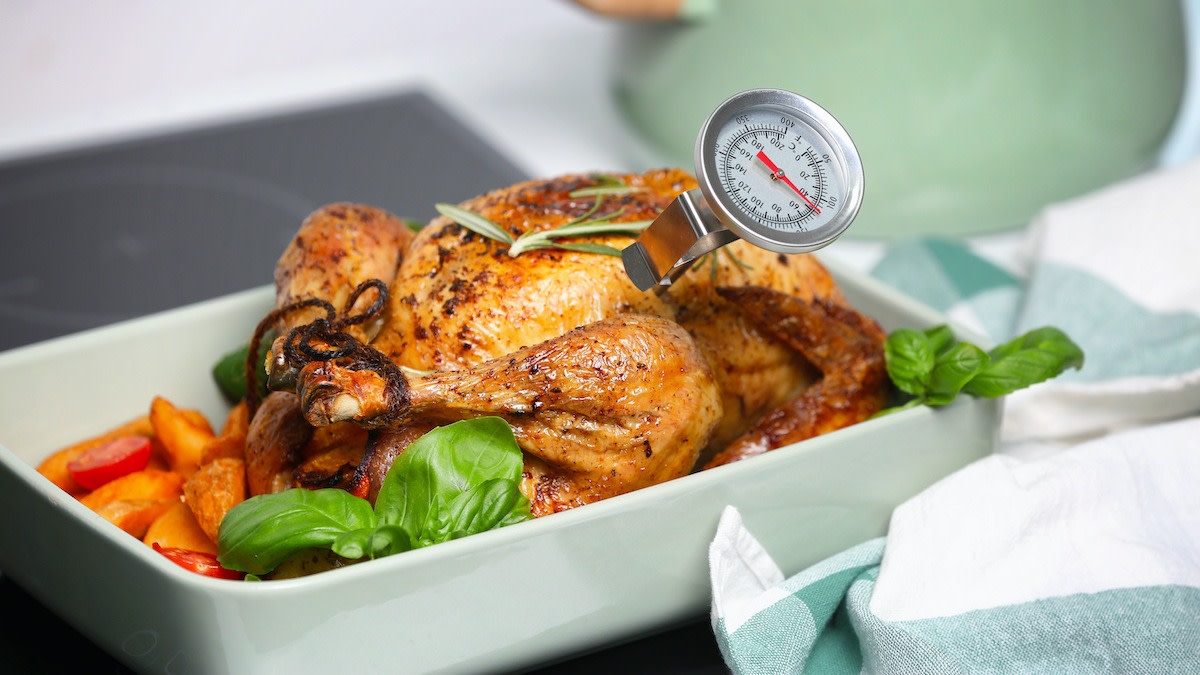How to Use a Meat Thermometer to Cook Food Properly
Written by MasterClass
Last updated: Jun 7, 2021 • 2 min read
Whether you’re cooking for yourself, your family, or a dinner party, you need to follow proper health and safety guidelines when handling food. A meat thermometer is a handy kitchen tool that can help you cook your chicken breasts, pork chops, and fish filets to the right temperatures every time.
Learn From the Best
What Is a Meat Thermometer?
A meat thermometer is a small, prong-type device that measures the internal temperatures of meats and other proteins. Foods like poultry, pork, and eggs need to reach a minimum internal temperature to destroy harmful bacteria and prevent food-borne illnesses. Meat thermometers allow you to gauge these internal temps without cutting into the proteins, which can negatively impact flavor and texture. Available in analog and digital versions, this essential kitchen tool can also help you cook protein to your preferred level of doneness.
What Is the Purpose of a Meat Thermometer?
Proteins like pork, chicken, and eggs must be cooked to a specific internal temperature to eliminate bacterias like E. coli and salmonella. The meat thermometer allows you to gauge when proteins reach the minimum internal temperature for safe consumption, without cutting into them, which can alter texture and flavor. For example, chicken must be cooked to an internal temperature of 165 degrees Fahrenheit, while ground meat must be cooked to at least 160 degrees Fahrenheit, and steak and pork must be at 145 degrees Fahrenheit to be consumed safely.
How to Use a Meat Thermometer
A meat thermometer is a simple kitchen tool to use. Check out the following steps to get an accurate reading every time:
- 1. Test your thermometer. Place the thermometer in a container full of ice and water and wait 20 seconds for a reading. If the temperature on the display reads 32 degrees Fahrenheit (or zero degrees Celsius), the thermometer is calibrated correctly and ready for use. If the thermometer does not reach the proper temperature, the calibration is off, and you may need to recalibrate according to the user instructions or buy a new thermometer.
- 2. Check the temperature during the cooking process. Removing the food from the heat source—your oven, stove, or grill—to measure the temperature can result in an inaccurate temperature reading. Insert the thermometer into the protein as it cooks on the heat source for an accurate reading. Remove the thermometer from the food after checking the temperature.
- 3. Place the thermometer in the thickest part of the food. To gauge the temperature of a large piece of meat, insert the thermometer probe through the center of the thickest part of the meat, avoiding any bones, fat, or gristle. Leave the thermometer in the meat for about 10 seconds to allow the temperature to register. (Remove the thermometer from the food after checking the temperature). The center part of the meat needs to reach the safe minimum temperature outlined by the Centers for Disease Control and Prevention (CDC), which has a breakdown of foods and the right temperatures to cook them on their website.
- 4. Read the thermometer. After gauging the temperature on a digital thermometer, check the instant digital readout to determine your food’s doneness. If you are using an analog thermometer, look at the small hand on the display’s dial to check the reading. If the temperature has not met the minimum safe temperature requirements, continue to cook and monitor your food’s temperature until it does.
Want to Learn More About Cooking?
Become a better chef with the MasterClass Annual Membership. Gain access to exclusive video lessons taught by culinary masters, including Gabriela Cámara, Chef Thomas Keller, Massimo Bottura, Dominique Ansel, Gordon Ramsay, Alice Waters, and more.
